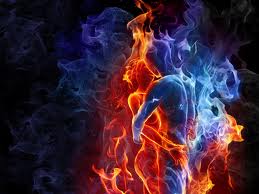Hi Influence of Ventilation in Residential Structures.
Photo Credit: Captain Jacob Brod, Pineville (NC) Fire Department
Kerber (2011) indicates that firefighters presume that if you create enough ventilation openings that the fire will return to a fuel controlled burning regime. I am not so sure that this is the case. Until fairly recently, the concept of burning regime and influence of increased ventilation on ventilation controlled fires was not well recognized in the US fire service. However, there has been a commonly held belief that increased ventilation will improve interior conditions and reduce the potential for extreme fire behavior phenomena such as flashover. In either case, the results of the experiments conducted by UL on the influence of horizontal ventilation cast considerable doubt on the ability to accomplish either of these outcomes using horizontal, natural ventilation.
The Experiments
In order to determine the impact of increased ventilation, Kerber (2011) compared changes in temperature with varied numbers and sizes of ventilation openings. The smallest ventilation opening in the experiments conducted in both the one and two story houses was when the door on Side A was used to provide the only opening. The largest number and size of ventilation openings was in the experiments where the front door and four windows were used (see Figures 1 and 3)
The area of ventilation openings in experiments conducted in the one-story house ranged from 1.77 m2 (19.1 ft2) using the front door only to 9.51 m2 (102.4 ft2) with the front door and four windows. In the two-story house the area of ventilation openings ranged from 1.77 m2 (19.1 ft2) with front door only to 14.75 m2 (158.8 ft2) using the front door and four windows.
The most dramatic comparison is between Experiments 1 and 2 where a single opening was used (front door) and Experiments 14 and 15 where five openings were used (door and four windows).
One Story House
Experiment 1 was conducted in the one-story house using the door on Side A as the only ventilation opening. The door was opened eight minutes after ignition (480 seconds). Experiment 14 was also conducted in the one-story house, but in this case the door on Side A and four windows were used as ventilation openings. Windows in the living room and bedrooms one, two, and three were opened sequentially immediately after the door was opened, providing more than five times the ventilation area as in Experiment 1 (door only).
Figure 1. Ventilation Openings in the One-Story House
In both Experiment 1 (door only) and Experiment 14 (door and four windows), increased ventilation resulted in transition to a fully developed fire in the compartment of origin (see Figure 2). In Experiment 1, a bi-directional air track developed at the door on Side A (flames out the top and air in the bottom). In Experiment 14, a bi-directional air track is visible at all ventilation openings, with flames visible from the door and window in the Living Room on Side A and flames visible through the window in Bedroom 3. No flames extended out the ventilation openings in Bedrooms 1, 2, and 3. The upper layer in Bedroom 3 is not deep, as such there is little smoke visible exiting the window, and it appears to be serving predominantly as an inlet. On the other hand, upper layer in Bedroom 2 is considerably deeper and a large volume of thick (optically dense) smoke is pushing from the window with moderate velocity. While a bi-directional air track is evident, this window is serving predominantly as an exhaust opening.
.jpg)
Figure 2. Fire Conditions at 600 seconds (10:00)
As illustrated in Figure 3, increased ventilation resulted in a increase in heat release rate and subsequent increase in temperature. It is important to note that the peak temperature in Experiment 14 (door and four windows) is more than 60% higher than in Experiment 1 (door only).
Figure 3. Living Room Temperature 0.30 m(1’) Above the Floor One-Story House
Note. Adapted from Impact of Ventilation on Fire Behavior in Legacy and Contemporary Residential Construction (p. 298), by Steve Kerber, 2011, Northbrook, IL: Underwriters Laboratories.
Based on observed conditions and temperature measurement within the one-story house, it is evident that increasing the ventilation from 1.77 m2 (19.1 ft2) using the front door to 9.51 m2 (102.4 ft2) with the front door and four windows did not return the fire to a fuel controlled burning regime and further, did not improve interior conditions.
It is important to note that these experiments were conducted without coordinated fire control operations in order to study the effects of ventilation on fire behavior. Conditions changed quickly in both experiments, but the speed with which the fire transitioned from decay to growth and reached flashover was dramatically more rapid with a larger ventilation area (i.e., door and four windows).
Two Story House
Experiment 2 was conducted in the two-story house using the door on Side A as the only ventilation opening. The door was opened ten minutes after ignition (600 seconds). Experiment 15 was also conducted in the two-story house, but in this case the door on Side A and four windows were used as ventilation openings. One window in the Living Room (Floor 1, Side A, below Bedroom 3) Den (Floor 1, Side C, below Bedroom 2) and two windows in the Family Room (Side C) were opened sequentially immediately after the door was opened, providing more than eight times the ventilation area as in Experiment 2 (door only).
Figure 4. Ventilation Openings in the Two-Story House
In both Experiment 2 (door only) and Experiment 15 (door and four windows), increased ventilation resulted in transition to a fully developed fire in the compartment of origin. Flames were seen from the family room windows in Experiment 15 (see Figure 5). However, in Experiment 2, no flames were visible on the exterior (due to the distance between the fire compartment and ventilation opening) and a bi-directional air track developed at the door on Side A (smoke out the top and air in the bottom). In Experiment 15, a bi-directional air track is visible at all ventilation openings, with flames visible from the windows in the family room on Side C. No flames extended out the ventilation openings on Side A or from the Den on Side C (see Figure 5). The upper layer is extremely deep (particularly considering the ceiling height of 16’ in the family room and foyer atrium. The velocity of smoke discharge from ventilation openings is moderate.
Figure 5. Fire Conditions at 780 seconds (13:00)
As illustrated in Figure 6, increased ventilation resulted in a increase in heat release rate and subsequent increase in temperature. It is important to note that the peak temperature in Experiment 15 (door and four windows) is approximately 50% higher than in Experiment 2 (door only).
Figure 6. Living Room Temperature 0.30 m(1’) Above the Floor One-Story House
Note. Adapted from Impact of Ventilation on Fire Behavior in Legacy and Contemporary Residential Construction (p. 299), by Steven Kerber, 2011, Northbrook, IL: Underwriters Laboratories.
Another Consideration
Comparison of these experiments answers the questions if increased horizontal ventilation would 1) return the fire to a fuel controlled state or 2) improve interior conditions. In a word, no, increased horizontal ventilation without concurrent fire control simply increased the heat release rate (sufficient for the fire to transition through flashover to a fully developed stage) in the involved compartment.
Examining thermal conditions in other areas of the building also provides an interesting perspective on these two sets of experiments. Figure 7 illustrates temperatures at 0.91 m (3’) during Experiment 1 (door only) and Experiment 14 (door and four windows) in the one-story house.
Figure 7. Temperatures at 0.91 m (3’) during Experiments 1 and 14
Note. Adapted from Impact of Ventilation on Fire Behavior in Legacy and Contemporary Residential Construction (p. 99, p. 162), by Steven Kerber, 2011, Northbrook, IL: Underwriters Laboratories.
Thermal conditions not only worsened in the fire compartment, but also along the flow path and in downstream compartments. Temperature in the hallway increased from a peak of just over 200o C to approximately 900o C when ventilation was increased by opening the four additional windows.
Unplanned Ventilation
Each of the experiments in this study were designed to examine the impact of tactical ventilation when building ventilation was limited to normal leakage and fire conditions are ventilation controlled (decay stage). In each of these experiments, increased ventilation resulted in a rapid increase in heat release rate and temperature. Even when ventilation was increased substantially (as in Experiments 14 and 15), it was not possible to return the fire to a fuel controlled burning regime.
It is also possible that a door or window will be left open by an exiting occupant or that the fire may cause window glazing to fail. The impact of these types of unplanned ventilation will have an effect on fire development. Creation of an opening prior to the fire reaching a ventilation controlled burning regime will potentially slow fire progression. However, on the flip side, providing an increased oxygen supply will allow the fire to continue to grow, potentially reaching a heat release rate that will result in flashover. If the opening is created after the fire is ventilation controlled, the results would be similar to those observed in each of these experiments. When the fire is ventilation controlled, increased ventilation results in a significant and dramatic increase in heat release rate and worsening of thermal conditions inside the building.
If the fire has self-ventilated or an opening has been created by an exiting occupant, the increased ventilation provided by creating further openings without concurrent fire control will result in a higher heat release rate than if the openings were not present and will likely result in rapid fire progression.


.jpg)





.jpg)






